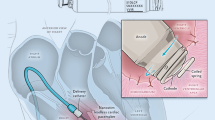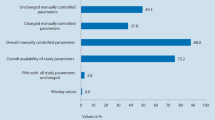Summary
Background
Electrical stimulation therapy (EST) and transcutaneous electrical neuromuscular stimulation (TENS), a modality of EST, have become widely applied, accepted and effective methods for the treatment of musculoskeletal and other pain conditions. According to the rising number of permanent pacemaker (PM) wearers the number of potential candidates for EST with concomitant device implantation is growing. Contradictory recommendations exist regarding the application of EST or TENS on PM wearers.
Aim
The study was carried out to evaluate the impact of EST on PM function.
Methods
A full size model mimicking the electrical characteristics of the human body was used to evaluate the application of EST on permanent PM devices. Various configurations with respect to energy modality, position of the stimulation electrodes and PM device models were evaluated. Intracardiac PM electrogram tracings (iEGM) were analyzed for the interference of EST with PM function.
Results
Unilateral EST application did not cause interference with PM function in any of the configurations (0%; n = 700). On the contrary, bilateral stimulation (350 configurations in total) caused either ventricular inhibition or switch to V00 back-up pacing due to electrical interference in 165 cases (47.1%) depending on the applied stimulation parameters.
Conclusion
The use of EST potentially interferes with PM therapy, especially if the electrodes are positioned bilaterally; however, unilateral EST application appeared to be safe in all tested configurations.




Similar content being viewed by others
Abbreviations
- EST:
-
Electrical stimulation therapy
- ICD:
-
Implantable cardioverter defibrillator
- iEGM:
-
Intracardiac pacemaker electrogram tracing
- PM:
-
Pacemaker
- TENS:
-
Transcutaneous electrical nerve stimulation
References
Mulvey MR, Fawkner HJ, Johnson MI. An investigation of the effects of different pulse patterns of transcutaneous electrical nerve stimulation (TENS) on perceptual embodiment of a rubber hand in healthy human participants with intact limbs. Neuromodulation. 2015;18(8):744–50.
Johnson MI, Paley CA, Howe TE, Sluka KA. Transcutaneous electrical nerve stimulation for acute pain. Cochrane Database Syst Rev. 2015;6:CD6142.
Raatikainen MJ, Arnar DO, Zeppenfeld K, Merino JL, Levya F, Hindriks G, et al. Statistics on the use of cardiac electronic devices and electrophysiological procedures in the European Society of Cardiology countries: 2014 report from the European Heart Rhythm Association. Europace. 2015;17(Suppl 1):i1–i75.
Glotzer TV, Gordon M, Sparta M, Radoslovich G, Zimmerman J. Electromagnetic interference from a muscle stimulation device causing discharge of an implantable cardioverter defibrillator: epicardial bipolar and endocardial bipolar sensing circuits are compared. Pacing Clin Electrophysiol. 1998;21(10):1996–8.
Siu CW, Tse HF, Lau CP. Inappropriate implantable cardioverter defibrillator shock from a transcutaneous muscle stimulation device therapy. J Interv Card Electrophysiol. 2005;13(1):73–5.
Wayar L, Mont L, Silva RM, Alvarenga N, Fosch X, Castro J, et al. Electrical interference from an abdominal muscle stimulator unit on an implantable cardioverter defibrillator: report of two consecutive cases. Pacing Clin Electrophysiol. 2003;26(5):1292–3.
Holmgren C, Carlsson T, Mannheimer C, Edvardsson N. Risk of interference from transcutaneous electrical nerve stimulation on the sensing function of implantable defibrillators. Pacing Clin Electrophysiol. 2008;31(2):151–8.
Pyatt JR, Trenbath D, Chester M, Connelly DT. The simultaneous use of a biventricular implantable cardioverter defibrillator (ICD) and transcutaneous electrical nerve stimulation (TENS) unit: implications for device interaction. Europace. 2003;5(1):91–3.
Rasmussen MJ, Hayes DL, Vlietstra RE, Thorsteinsson G. Can transcutaneous electrical nerve stimulation be safely used in patients with permanent cardiac pacemakers? Mayo Clin Proc. 1988;63(5):443–5.
Carlson T, Andrell P, Ekre O, Edvardsson N, Holmgren C, Jacobsson F, et al. Interference of transcutaneous electrical nerve stimulation with permanent ventricular stimulation: a new clinical problem? Europace. 2009;11(3):364–9.
Irnich W. Interference in pacemakers. Pacing Clin Electrophysiol. 1984;7(6 Pt 1):1021–48.
Crevenna R, Stix G, Pleiner J, Pezawas T, Schmidinger H, Quittan M, et al. Electromagnetic interference by transcutaneous neuromuscular electrical stimulation in patients with bipolar sensing implantable cardioverter defibrillators: a pilot safety study. Pacing Clin Electrophysiol. 2003;26(2 Pt 1):626–9.
Digby GC, Daubney ME, Baggs J, Campbell D, Simpson CS, Redfearn DP, et al. Physiotherapy and cardiac rhythm devices: a review of the current scope of practice. Europace. 2009;11(7):850–9.
Bradshaw PJ, Stobie P, Knuiman MW, Briffa TG, Hobbs MS. Trends in the incidence and prevalence of cardiac pacemaker insertions in an ageing population. Open Heart. 2014;1(1):e177.
Pergolizzi JV Jr., Raffa RB, Fleischer C, Zampogna G, Taylor R Jr.. Management of moderate to severe chronic low back pain with buprenorphine buccal film using novel bioerodible mucoadhesive technology. J Pain Res. 2016;9:909–16.
Tsang A, Von Korff M, Lee S, Alonso J, Karam E, Angermeyer MC, et al. Common chronic pain conditions in developed and developing countries: gender and age differences and comorbidity with depression-anxiety disorders. J Pain. 2008;9(10):883–91.
Jauregui JJ, Cherian JJ, Gwam CU, Chughtai M, Mistry JB, Elmallah RK, et al. A meta-analysis of transcutaneous electrical nerve stimulation for chronic low back pain. Surg Technol Int. 2016;28:296–302.
Acknowledgements
This work was supported by the Association for the Promotion of Research in Atherosclerosis, Thrombosis and Vascular Biology, the Ludwig Boltzman Foundation for Cardiovascular Research and the Ludwig Boltzman Institute for Electrical Stimulation and Physical Rehabilitation.
Funding
This pece of research did not reveive any specific funding or grant. However the authors could use the facilities from the Association for the Promotion of Research in Atherosclerosis, Thrombosis and Vascular Biology, the Ludwig Boltzman Foundation for Cardiovascular Research and the Ludwig Boltzman Institute for Electrical Stimulation and Physical Rehabilitation to conduct their research. Consequently this appears to be no contradiction to the authors.
Author information
Authors and Affiliations
Corresponding author
Ethics declarations
Conflict of interest
F. Egger reports personal fees from Medtronic outside the submitted work. M. Nürnberg reports personal fees from Medtronic, Biotronik, Boston Scientific, St. Jude Medical/Abbott and Sorin outside the submitted work. L. Fiedler reports personal fees from Boston Scientific and St. Jude Medical/Abbott outside the submitted work. C. Hofer, F.P. Hammerle, S. Löfler, R. Kriz, H. Kern and K. Huber have no conflicts of interest with respect to this publication.
Additional information
Publisher’s Note
Springer Nature remains neutral with regard to jurisdictional claims in published maps and institutional affiliations.
Florian Egger and Christian Hofer contributed equally to the manuscript.
Rights and permissions
About this article
Cite this article
Egger, F., Hofer, C., Hammerle, F.P. et al. Influence of electrical stimulation therapy on permanent pacemaker function. Wien Klin Wochenschr 131, 313–320 (2019). https://doi.org/10.1007/s00508-019-1494-5
Received:
Accepted:
Published:
Issue Date:
DOI: https://doi.org/10.1007/s00508-019-1494-5




